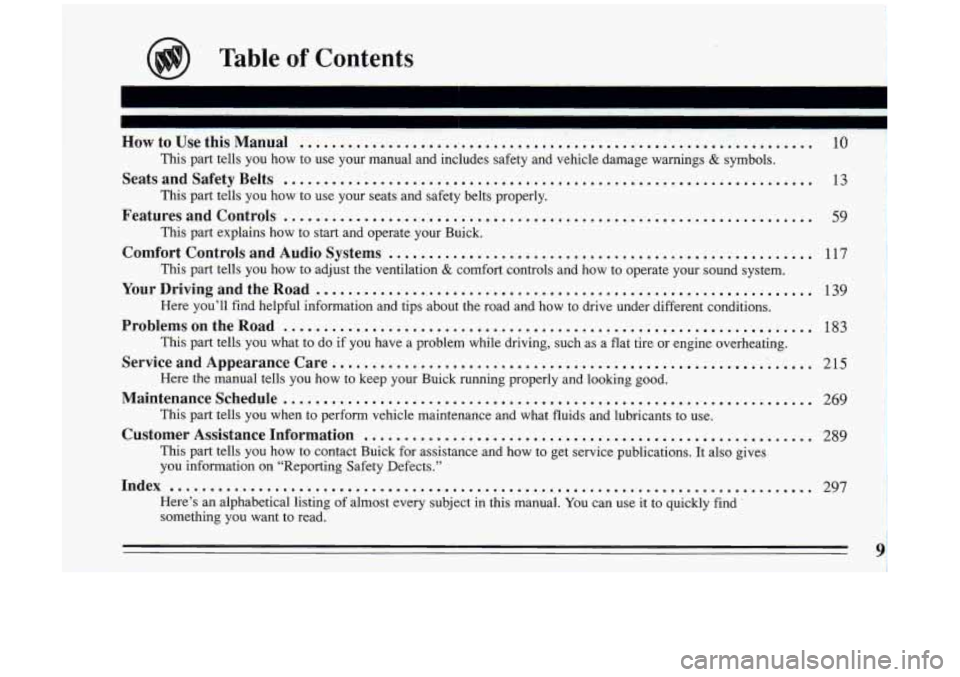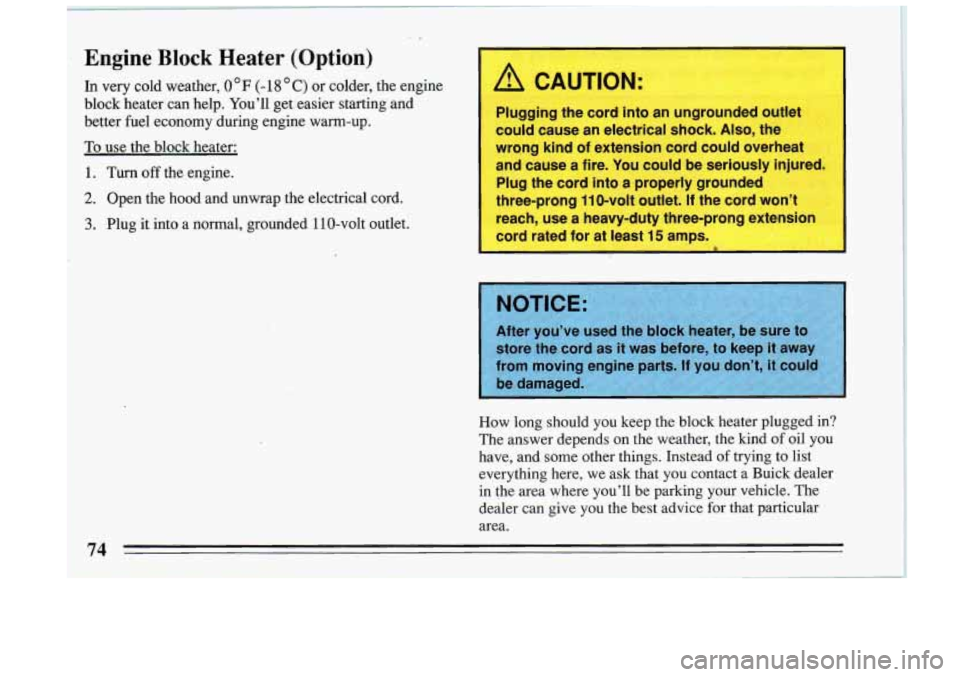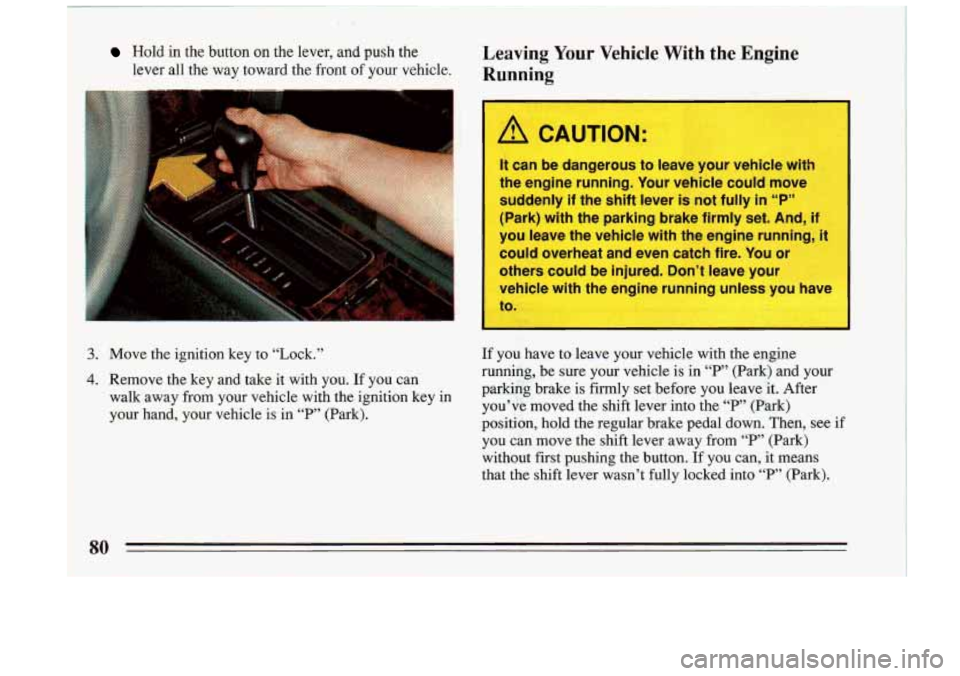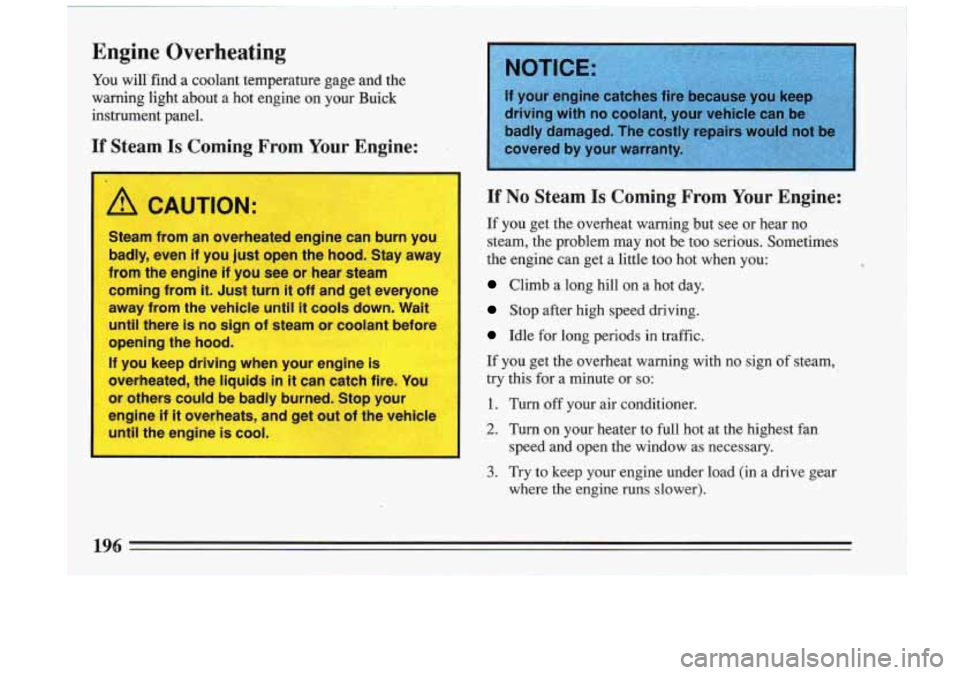Page 12 of 324

HowtoUsethisManual ................................................................
This part tells you how to use your manual and includes safety and vehicle damage warnings & symbols.
SeatsandSafetyBelts ..................................................................
This part tells you how to use your seats and safety belts properly.
Featuresandcontrols ..................................................................
This part explains how to start and operate your Buick.
This part tells you how to adjust the ventilation
& comfort controls and how to operate your sound system.
YourDrivingandtheRoad ..............................................................
Here you’ll find helpful information and tips about the road and how to drive under different conditions.
ProblemsontheRoad ..................................................................
This part tells you what to do if you have a problem while driving, such as a flat tire or engine overheating.
ServiceandAppearanceCare ............................................................
Here the manual tells you how to keep your Buick running properly and looking good.
Maintenanceschedule ..................................................................
This part tells you when to perform vehicle maintenance and what fluids and lubrica\
nts to use.
Customer Assistance Information ........................................................
This part tells you how to contact Buick for assistance and how to get service publications. It also gives
you information on “Reporting Safety Defects.”
Index ........................................................................\
........
Here’s an alphabetical listing of almost every subject in this manual. You can use it to quickly find
something
you want to read.
Comfort Controls and Audio Systems .....................................................
10
13
59
117
139
183
215
269
289
297
Page 76 of 324

Engine Block Heater (Option)
In very cold weather, 0 F (- 18 C) or colder, the engine
block heater can help. You’ll get easier starting and
better fuel economy during engine warm-up.
j To use the block heater: I
I. Turn off the engine.
L. Open the hood and unwrap the electrical cord.
1 3. Plug it into a normal, grounded 110-volt outlet.
A CAUTION:
Plugging the cord into an ungrounded outlet
could cause an electrical shock.
Also, the
wrong kind of extension cord could overheat
and cause
a fire. You could be seriously injured.
Plug the cord into
a properly grounded
three-prong 110-volt outlet.
If the cord won’t
reach, use
a heavy-duty three-prong extension
cord rated for at least
15 amps.
How long should you keep the block heater-plugged in?
The answer depends on the weather, the kind
of oil you
have, and some other things. Instead
of trying to list
everything here, we ask that you contact
a Buick dealer
in the area where you’ll be parking your vehicle. The
dealer
can give you the best advice for that particular
area.
74
Page 82 of 324

Hold in the button on the lever, and push the Leaving Your Vehicle With the Engine
I lever all the way toward the front of your vehicle. Running
3. Move the ignition key to “Lock.”
4. Remove the key and take it with you. If you can
walk away from your vehicle with the ignition key in
your hand, your vehicle is in
“P)’ (Park).
A CAUTION:
It can be dangerous to leave your vehicle with
the engine running. Your vehicle could move
suddenly
if the shift lever is not fully in “P”
(Park) with the parking brake firmly set. And,
if
you leave the vehicle with the engine running, it
could overheat and even catch fire. You or
others could be injured. Don’t leave your
vehicle with the engine running unlesr --ou have
to.
I
If you. have to leave your vehicle .with the engine
running, be sure your vehicle is in
“P” (Park) and your
parking brake is firmly set before
you leave it. After
you’ve moved the shift lever into the
“P” (Park)
position, hold the regular brake pedal down. Then, see if
you can move the shift lever away from “P,’ (Park)
without first pushing the button.
If you can, it means
that the shift lever wasn’t fully locked into
T“ (Park).
so
Page 115 of 324
Engine Coolant Temperature Warning
Light and Gage Malfunction Indicator Lamp (Service
Engine Soon Light)
the engine off as soon as
possible.
HOT COOLANT CAN
BURN YOU BADLY!
In “Problems on the Road,” this manual shows what to
do. See “Engine Overheating” in the Index. A computer monitors operation
of your fuel, ignition
and emission control systems. This light should come on when the ignition
is on, but the engine is not running, as
a check to show you it
is working. If it does not come on
at all, have it fixed right away. If it stays
on, or it comes
on while you are driving, the computer is indicating that
you have a problem. You should take your vehicle in for
service soon.
113
Page 198 of 324

Engine Overheating
You willi find a coolant temperature gage and the
warning light about a hot engine on your Buick
instrument panel.
If Steam Is Coming From Your Engine:
I
A CAUTION:
Steam from an overheated engine can burn you
badly, even if you just open the hood. Stay away
from the engine if you see or hear steam
coming from
it. Just turn it off and get everyone
away from the vehicle until
it cools down. Wait
until there is no sign of steam or coolant before
opening the hood.
If you keep driving when your engine is
overheated, the liquids in it can catch fire. You
or others could be badly burned. Stop your
engine if
it overheats, and get out of the vehicle
until the engine is cool.
If No Steam Is Coming From Your Engine:
If you get the overheat warning but see or hear no
steam, the problem may not be too serious. Sometimes
the engine can get a little too hot when you:
Climb a long hill on a hot day.
Stop after high speed driving.
Id.le for long periods in traffic.
If you get the overheat warning with no sign of steam,
try this for a minute or
so:
1. Turn off your air conditioner.
2. Turn on your heater to full hot at the highest fan
3. Try to keep your engine under load (in a drive gear
speed and open the window as necessary.
where the engine runs slower).
Page 199 of 324
If you no longer have the overheat warning, you can
drive. Just to be safe, drive slower for about ten minutes.
If the warning doesn't come back on, you can drive
normally.
If~the warning continues, pull over, stop, and park your
vehicle right away.
If there's still no
sign of steam, you can idle the engine
for two or three minutes while you're parked, to see
if
the warning stops. But then, if you still have the
warning,
TURN OFF THE ENGINE AND GET
EVERYONE OUT
OF THE VEHICLE until it cools
down. You may
decide not to lift the hood but to get service
help right away.
197
Page 201 of 324
I
A CAUTION:
' ~ Heater and radiator hoses, and other engine
--# parts, can be very hot. Don't touch them. If you I 1
.': do, you can be burned.
Don't
run the engine if there is a leak. If you run
the engine,
it could lose all coolant. That could
..~ cause an engine fire, and you could be burned.
I_ '1 Get any leak fixed before you drive the vehicle. /I
,
A CAUTION:
Adding only plain water to your cooling system
can be dangerous. Plain water, or some other
liquid like alcohol, can boil before the proper
coolant mix
will. Your vehicle's coolant warning
system
is set for the proper coolant mix. With
plain water or the wrong mix, your engine could
get too hot but you wouldn't get the overheat
warning. Your engine could catch fire and you
or others could be burned. Use a
5060 mix of
clean water and a proper antifreeze.
Page 202 of 324
I
I
CAUTION:
You can be burned if you spill coolant on hot
engine parts. Coolant contains ethylene glycol
and it will burn
if the engine parts are hot
enough. Don’t spill coolant on a hot engine.
When the coolant in the coolant recovery tank is at or
above
“FULL COLD,” start your vehicle.
If the overheat warning continues, there’s one more
thing
you can try. You can add the proper coolant mix
directly to the radiator, but be sure the cooling system is
cool before
you do it.